Synthesis, Characterization and Enhanced Sensing Properties of a NiO/ZnO p–n Junctions Sensor for the SF6 Decomposition Byproducts SO2, SO2F2, and SOF2
Abstract
:1. Introduction
2. Experimental Details
2.1. Preparation and Characterization of Materials
2.2. The Fabrication of Sensors
2.3. Gas Response Measurement
3. Results and Discussion
3.1. Structural and Morphological Characterizations
3.2. Gas-Sensing Properties
3.3. Sensing Mechanisms
4. Conclusions
Acknowledgments
Author Contributions
Conflicts of Interest
References
- Seo, H.C.; Jang, W.H.; Kim, C.H.; Chung, Y.H.; Lee, D.S.; Rhee, S.B. Analysis of Magnitude and Rate-of-Rise of VFTO in 550 kV GIS Using EMTP-RV. J. Electr. Eng. Technol. 2013, 8, 11–19. [Google Scholar] [CrossRef]
- Ma, G.M.; Wu, Z.; Zhou, H.Y.; Jiang, J.; Chen, W.X.; Zheng, S.S.; Li, C.R.; Li, X.; Wang, Z.B. A Wireless and Passive Online Temperature Monitoring System for GIS Based on Surface-Acoustic-Wave Sensor. IEEE Trans. Power Deliv. 2016, 31, 1270–1280. [Google Scholar] [CrossRef]
- Istad, M.; Runde, M. Thirty-Six Years of Service Experience with a National Population of Gas-Insulated Substations. IEEE Trans. Power Deliv. 2010, 25, 2448–2454. [Google Scholar] [CrossRef]
- Beyer, C.; Jenett, H.; Kfockow, D. Influence of reactive SFX gases on electrode surfaces after electrical discharges under SF6 atmosphere. IEEE Trans. Dielectr. Electr. Insul. 2000, 7, 234–240. [Google Scholar] [CrossRef]
- Tang, J.; Zeng, F.P.; Yu, J.Y.; Zhang, X.X.; Yao, Q.; He, J.J.; Hou, X.Z. Correlation analysis between formation process of SF6 decomposed components and partial discharge qualities. IEEE Trans. Dielectr. Electr. Insul. 2013, 20, 864–875. [Google Scholar] [CrossRef]
- Zhang, X.X.; Tie, J.; Chen, Q.C. Pt-Doped TiO2-Based Sensors for Detecting SF6 Decomposition Components Decomposed Components. IEEE Trans. Dielectr. Electr. Insul. 2015, 22, 1559–1566. [Google Scholar] [CrossRef]
- Zhang, X.X.; Tie, J.; Zhang, J.B. A Pt-Doped TiO2 Nanotube Arrays Sensor for Detecting SF6 Decomposition Products. Sensors 2013, 13, 14764–14776. [Google Scholar] [CrossRef] [PubMed]
- Piemontesi, M.; Niemeyer, L. Sorption of SF6 and SF6 Decomposition Products by Activated Alumina and Molecular Sieve 13X. In Proceedings of the 1996 IEEE International Symposium Electrical Insulation, Montreal, QC, Canada, 16–19 June 1996; Volume 2, pp. 16–19. [Google Scholar]
- Zhang, X.X.; Meng, F.S.; Yang, B. Use of Hydroxyl-modified Carbon Nanotubes for Detecting SF6 Decomposition Products under Partial Discharge in Gas Insulated Switchgear. IEEE Trans. Dielectr. Electr. Insul. 2013, 20, 2246–2253. [Google Scholar] [CrossRef]
- Li, Q.M.; Cong, H.X.; Xing, J.Y.; Qi, B.; Li, C.R. On-Line Temperature Monitoring of the GIS Contacts Based on Infrared Sensing Technology. J. Electr. Eng. Technol. 2014, 9, 1385–1393. [Google Scholar] [CrossRef]
- Zhang, X.X.; Zhang, J.B.; Jia, Y.C.; Xiao, P.; Tang, J. TiO2 Nanotube Array Sensor for Detecting the SF6 Decomposition Product SO2. Sensors 2012, 12, 3302–3313. [Google Scholar] [CrossRef] [PubMed]
- Kurte, R.; Heise, H.M.; Klockow, D. Quantitative infrared spectroscopic analysis of SF6 decomposition products obtained by electrical partial discharges and sparks using PLS-calibrations. J. Mol. Struct. 2001, 565, 505–513. [Google Scholar] [CrossRef]
- Luo, J.; Fang, Y.H.; Su, Z.X.; Li, D.C.; Zhao, Y.D.; Wang, A.J.; Wu, J.; Cui, F.X.; Li, Y.Y. The research of temperature properties of photoacoustic spectroscopy detection for SF6 decomposition products in gas insulated switchgear. Anal. Methods 2015, 7, 3806–3813. [Google Scholar] [CrossRef]
- Hergli, R.; Casanovas, J.; Derdouri, A.; Grob, R.; Mathieu, J. Study of The Decomposition of SF6 in the Presence of Water, Subjected to Gamma-Irradiation or Corona Discharges. IEEE Trans. Electr. Insul. 1988, 23, 451–465. [Google Scholar] [CrossRef]
- Liu, W.L.; Liu, Y.Y.; Do, J.S.; Li, J. Highly sensitive room temperature ammonia gas sensorbased on Ir-doped Pt porous ceramic electrodes. Appl. Surf. Sci. 2016, 390, 929–935. [Google Scholar] [CrossRef]
- Ayesh, A.I. Linear hydrogen gas sensors based on bimetallic nanoclusters. J. Alloy. Compd. 2016, 689, 1–5. [Google Scholar] [CrossRef]
- Dashtian, K.; Zare-Dorabei, R. Preparation and characterization of a novel optical chemical sensor for determination of trace amounts of Praseodymium ion by UV/Vis spectrophotometry. Sens. Actuators B Chem. 2017, 242, 586–594. [Google Scholar] [CrossRef]
- Altamura, G.; Wang, M.Q.; Choy, K.L. Improving efficiency of electrostatic spray-assisted vapor eposited Cu2ZnSn(S,Se)(4) solar cells by modification of Mo/absorber interface. Thin Solid Films 2015, 597, 19–24. [Google Scholar] [CrossRef]
- Galstyan, V.; Comini, E.; Kholmanov, I.; Faglia, G.; Sberveglieri, G. Reduced graphene oxide/ZnO nanocomposite for application in chemical gas sensors. RSC Adv. 2016, 6, 34225–34232. [Google Scholar] [CrossRef]
- Spencer, M.J.S. Gas sensing applications of 1D-nanostructured zinc oxide: Insights from density functional theory calculations. Prog. Mater. Sci. 2012, 7, 437–486. [Google Scholar] [CrossRef]
- Galstyan, V.; Comini, E.; Ponzoni, A.; Sberveglieri, V.; Sberveglieri, G. ZnO Quasi-1D Nanostructures: Synthesis, Modeling, and Properties for Applications in Conductometric Chemical Sensors. Chemosensors 2016, 4, 6. [Google Scholar] [CrossRef]
- Zoshki, A.; Rahmani, M.B.; Masdarolomoor, F.; Pilehrood, S.H. Room Temperature Gas Sensing Properties of Polyaniline/ZnO Nanocomposite Thin Films. J. Nanoelectron. Optoelectron. 2017, 12, 465–471. [Google Scholar] [CrossRef]
- Qu, Z.; Fu, Y.M.; Yu, B.W.; Deng, P.; Xing, L.L.; Xue, X.Y. High and fast H2S response of NiO/ZnO nanowire nanogenerator as a self-powered gas sensor. Sens. Actuators B Chem. 2016, 222, 78–86. [Google Scholar] [CrossRef]
- Li, C.; Feng, C.H.; Qu, F.D.; Liu, J.; Zhu, L.H.; Lin, Y.; Wang, Y.; Li, F.; Zhou, J.R.; Ruan, S.P. Electrospun nanofibers of p-type NiO/n-type ZnO heterojunction with different NiO content and its influence on trimethylamine sensing properties. Sens. Actuators B Chem. 2015, 207, 90–96. [Google Scholar] [CrossRef]
- Tian, F.S.; Liu, Y.L. Synthesis of p-type NiO/n-type ZnO heterostructure and its enhanced photocatalytic activity. Scr. Mater. 2013, 69, 417–419. [Google Scholar] [CrossRef]
- Liu, Y.L.; Li, G.Z.; Mi, R.D.; Deng, C.K.; Gao, P.Z. An environment-benign method for the synthesis of p-NiO/n-ZnO heterostructure with excellent performance for gas sensing and photocatalysis. Sens. Actuators B Chem. 2014, 191, 537–544. [Google Scholar] [CrossRef]
- Dai, W.; Pan, X.H.; Chen, S.S.; Chen, C.; Wen, Z.; Zhang, H.H.; Ye, Z.Z. Honeycomb-like NiO/ZnO heterostructured nanorods: Photochemical synthesis, characterization, and enhanced UV detection performance. J. Mater. Chem. C 2014, 2, 4604–4614. [Google Scholar] [CrossRef]
- Tian, H.L.; Fan, H.Q.; Dong, G.Z.; Ma, L.T.; Ma, J.W. NiO/ZnO p–n heterostructures and their gas sensing properties for reduced operating temperature. RSC Adv. 2016, 6, 109091–109098. [Google Scholar] [CrossRef]
- Zhou, Q.; Liu, H.C.; Hong, C.X.; Xu, L.N.; Chen, W.G. Fabrication and Enhanced Acetylene Sensing Properties of PdO-Decorated SnO2 Composites Chemical Sensor. Sensor Lett. 2016, 14, 1144–1149. [Google Scholar] [CrossRef]
- Zhou, Q.; Tang, C.; Zhu, S.P.; Chen, W.G.; Li, J. Fabrication and Characterization of Hydrogen Sensor Based on Hierarchical Pine-Needle Shape SnO2 Nanostructures. Sens. Lett. 2015, 13, 900–905. [Google Scholar] [CrossRef]
- Thi, T.V.; Rai, A.K.; Gim, J.; Kim, J. High performance of Co-doped NiO nanoparticle anodematerial for rechargeable lithium ion batteries. J. Power Sour. 2015, 292, 23–30. [Google Scholar] [CrossRef]
- Zhou, Q.; Xie, B.; Jin, L.F.; Chen, W.G.; Li, J. Hydrothermal Synthesis and Responsive Characteristics of Hierarchical Zinc Oxide Nanoflowers to Sulfur Dioxide. J. Nanosci. Nanotechnol. 2016, 2016, 6742104. [Google Scholar] [CrossRef]
- Liu, C.; Zhao, L.; Wang, B.; Sun, P.; Wang, Q.; Gao, Y.; Liang, X.; Zhang, T.; Lu, G. Acetone gas sensor based on NiO/ZnO hollow spheres: Fast response and recovery, and low (ppb) detection limit. J. Colloid Interface Sci. 2017, 495, 207–215. [Google Scholar] [CrossRef] [PubMed]
- Tong, S.F.; Zheng, M.B.; Lu, Y.; Lin, Z.X.; Li, J.; Zhang, X.P.; Shi, Y.; He, P.; Zhou, H.S. Mesoporous NiO with a single-crystalline structure utilized as a noble metal-free catalyst for nonaqueous Li–O2 batteries. J. Mater. Chem. A 2015, 3, 16177–16182. [Google Scholar] [CrossRef]
- Guo, W.X.; Sun, W.W.; Wang, Y. Multilayer CuO@NiO Hollow Spheres: Microwave-Assisted Metal-Organic-Framework Derivation and Highly Reversible Structure-Matched Stepwise Lithium Storage. ACS Nano 2015, 9, 11462–11471. [Google Scholar] [CrossRef] [PubMed]
- Saaedi, A.; Yousefi, R.; Jamali-Sheini, F.; Zak, A.K.; Cheraghizade, M.; Mahmoudian, M.R.; Baghchesara, M.A.; Dezaki, A.S. XPS studies and photocurrent applications of alkali-metals-doped ZnO nanoparticles undervisible illumination conditions. Physica E 2016, 79, 113–118. [Google Scholar] [CrossRef]
- Ren, Y.R.; Wei, H.M.; Huang, X.B.; Yang, B.; Wang, J.W.; Ding, J.N. Fabrication of NiO Nanowires/G Composite as Electrode Material for High Performance Supercapacitor. Int. J. Electrochem. Sci. 2014, 9, 7206–7216. [Google Scholar]
- Wei, X.Q.; Man, B.Y.; Liu, M.; Xue, C.S.; Zhuang, H.Z.; Yang, C. Blue luminescent centers and microstructural evaluation by XPS and Raman in ZnO thin films annealed in vacuum, N2 and O2. Physica B 2007, 388, 145–152. [Google Scholar] [CrossRef]
- Zhou, Q.; Chen, W.G.; Peng, S.D.; Zeng, W. Hydrothermal Synthesis and Acetylene Sensing Properties of Variety Low Dimensional Zinc Oxide Nanostructures. Sci. World J. 2014, 2014, 489170. [Google Scholar] [CrossRef] [PubMed]
- Dong, X.C.; Zhang, X.X.; Wu, X.Q.; Cui, H.; Chen, D.C. Investigation of Gas-Sensing Property of Acid-Deposited Polyaniline Thin-Film Sensors for Detecting H2S and SO2. Sensors 2016, 16, 1889. [Google Scholar] [CrossRef] [PubMed]
- Kumar, R.; Al-Dossary, O.; Kumar, G.; Umar, A. Zinc Oxide Nanostructures for NO2 Gas-Sensor Applications: A Review. Nano Micro Lett. 2015, 7, 97–120. [Google Scholar] [CrossRef]
- Hosseini, Z.S.; Zad, A.I.; Mortezaali, A. Room temperature H2S gas sensor based on rather aligned ZnO nanorods with flower-likestructures. Sens. Actuators B Chem. 2015, 207, 865–871. [Google Scholar] [CrossRef]
- Peng, S.D.; Wu, G.L.; Song, W.; Wang, Q. Application of Flower-Like ZnO Nanorods Gas Sensor Detecting SF6 Decomposition Products. J. Nanomater. 2013, 2013, 135147. [Google Scholar] [CrossRef]
- Zhou, Q.; Chen, W.G.; Xu, L.N.; Peng, S.D. Hydrothermal Synthesis of Various Hierarchical ZnO Nanostructures and Their Methane Sensing Properties. Sensors 2013, 13, 6171–6182. [Google Scholar] [CrossRef] [PubMed]
- Wang, L.L.; Zhou, T.T.; Zhang, R.; Lou, Z.; Deng, J.N.; Zhang, T. Comparison of toluene sensing performances of zinc stannate with different morphology-based gas sensors. Sens. Actuators B Chem. 2016, 227, 448–455. [Google Scholar] [CrossRef]
- Zhao, X.D.; Ji, H.M.; Jia, Q.Q.; Wang, M.J. A nanoscale Co3O4-WO3 p–n junction sensor with enhanced acetone responsivity. J. Mater. Sci. Mater. Electron. 2015, 26, 8217–8233. [Google Scholar] [CrossRef]
- Wang, Y.; Zhang, H.; Sun, X.H. Electrospun nanowebs of NiO/SnO2 p–n heterojunctions for enhanced gas sensing. Appl. Surf. Sci. 2016, 389, 514–520. [Google Scholar] [CrossRef]
- Zhang, W.; Xie, C.S.; Zhang, G.Z.; Zhang, J.; Zhang, S.P.; Zeng, D.W. Porous LaFeO3/SnO2 nanocomposite film for CO2 detection with high sensitivity. Mater. Chem. Phys. 2017, 186, 228–236. [Google Scholar] [CrossRef]
- Ju, D.X.; Xua, H.Y.; Xua, Q.; Gong, H.B.; Qiu, Z.W.; Guo, J.; Zhang, J.; Cao, B.Q. High triethylamine- sensing properties of NiO/SnO2 hollow sphere p–n heterojunction sensors. Sens. Actuators B Chem. 2015, 215, 39–44. [Google Scholar] [CrossRef]
- Bai, S.L.; Guo, W.T.; Sun, J.H.; Li, J.; Tian, Y.; Chen, A.F.; Luo, R.X.; Li, D.Q. Synthesis of SnO2-CuO heterojunction using electrospinning and application in detecting of CO. Sens. Actuators B Chem. 2016, 226, 96–103. [Google Scholar] [CrossRef]
- Yamazoe, N.; Shimanoe, K. Theory of power laws for semiconductor gas sensors. Sens. Actuators B Chem. 2008, 128, 566–573. [Google Scholar] [CrossRef]
- Chen, Y.J.; Yu, L.; Feng, D.D.; Zhuo, M.; Zhang, M.; Zhang, E.N.; Xu, Z.; Li, Q.H.; Wang, T.H. Superior ethanol-sensing properties based on Ni-doped SnO2 p–n heterojunction hollow spheres. Sens. Actuators B Chem. 2012, 166–167, 61–67. [Google Scholar] [CrossRef]
- Zhang, X.X.; Yu, L.; Tie, J.; Dong, X.C. Gas Sensitivity and Sensing Mechanism Studies on Au-Doped TiO2 Nanotube Arrays for Detecting SF6. Sensors 2014, 14, 19517–19532. [Google Scholar] [CrossRef] [PubMed]
- Mane, A.T.; Navale, S.T.; Sen, S.; Aswal, D.K.; Gupta, S.K.; Patil, V.B. Nitrogen dioxide (NO2) sensing performance of p-polypyrrole/n-tungsten oxide hybrid nanocomposites at room temperature. Org. Electron. 2015, 16, 195–204. [Google Scholar] [CrossRef]
- Bai, S.L.; Chen, S.; Zhao, Y.B.; Guo, T.; Luo, R.X.; Li, D.Q.; Chen, A.F. Gas sensing properties of Cd-doped ZnO nanofibers synthesized by the electrospinning method. J. Mater. Chem. A 2014, 2, 16697–16706. [Google Scholar] [CrossRef]
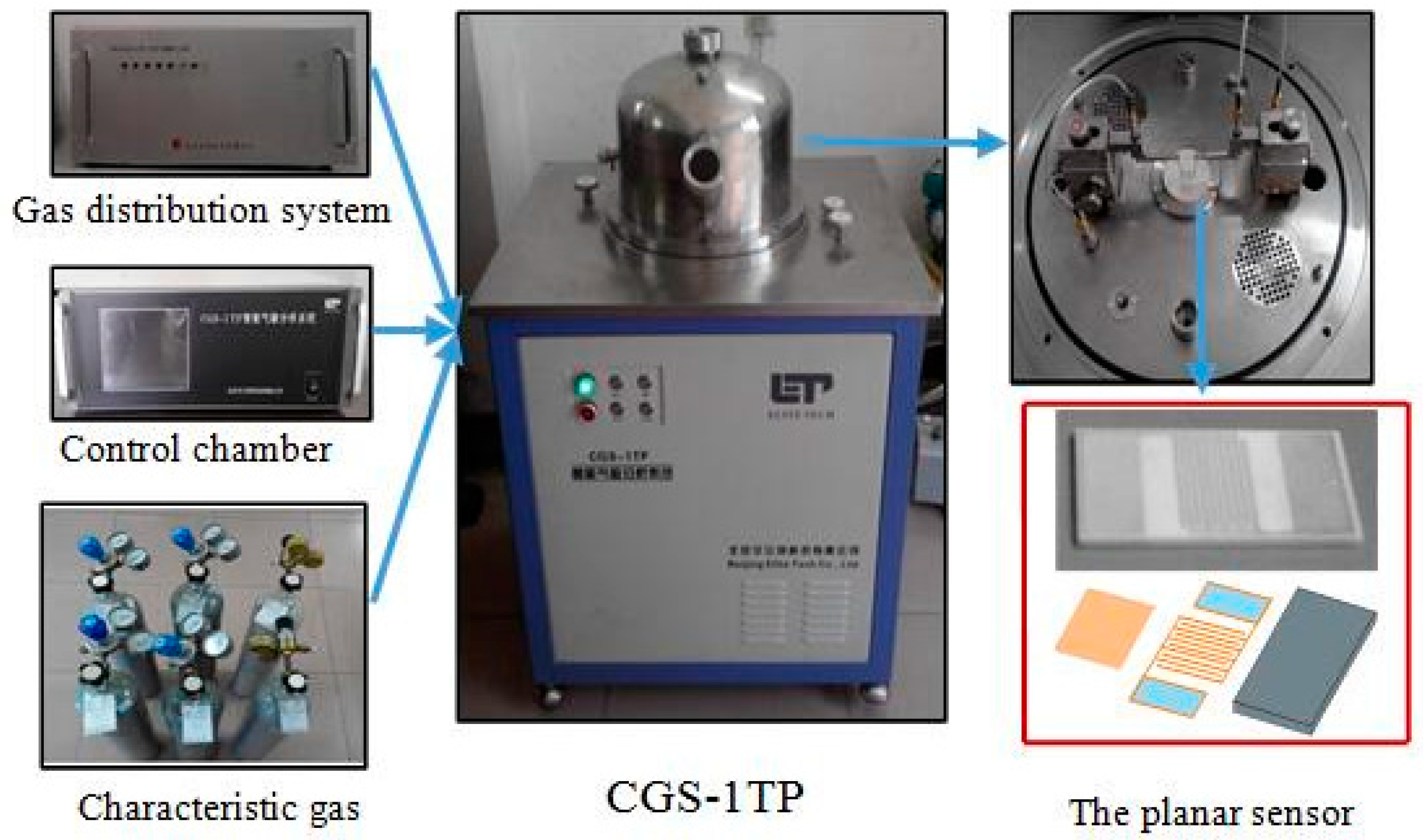
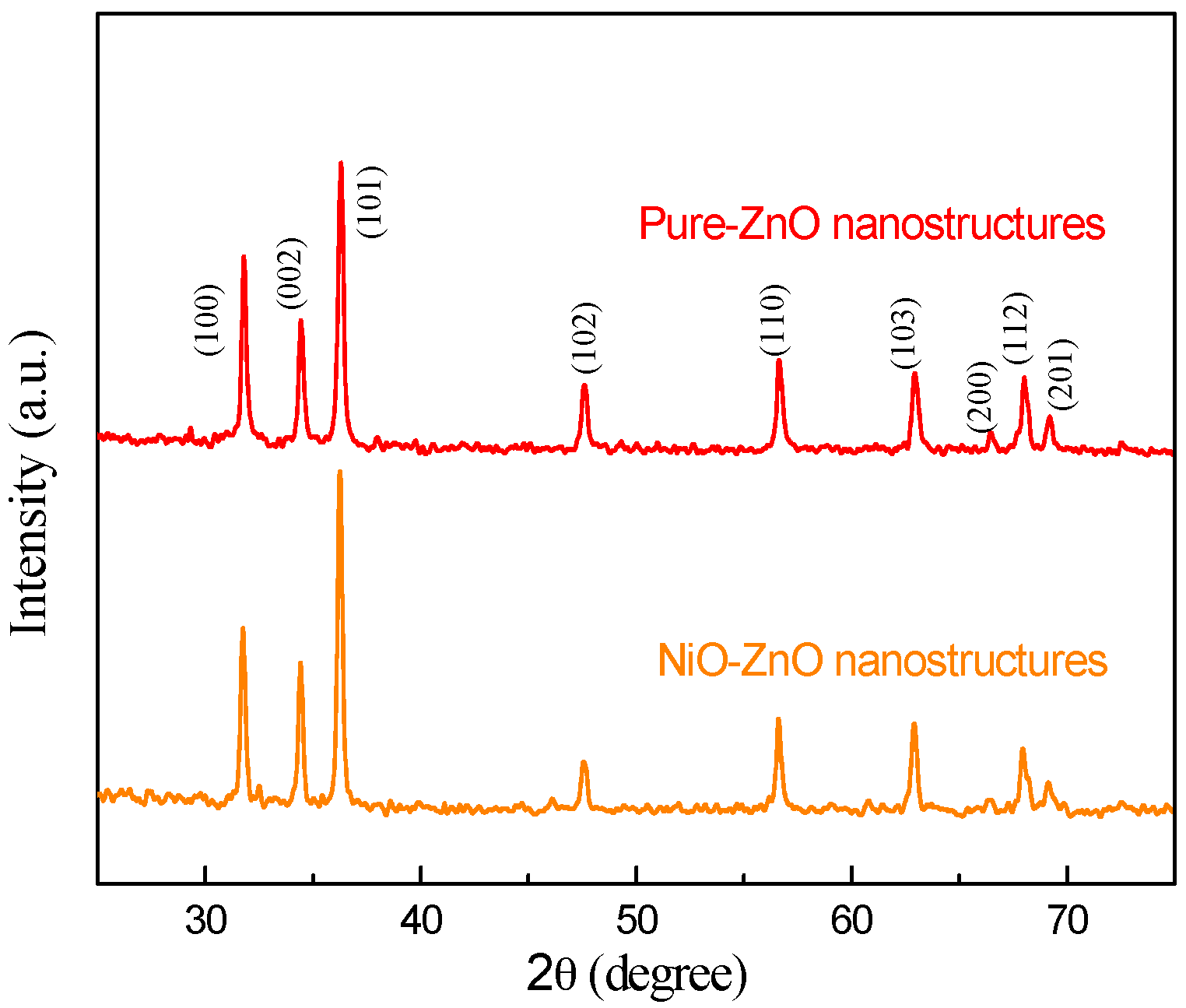
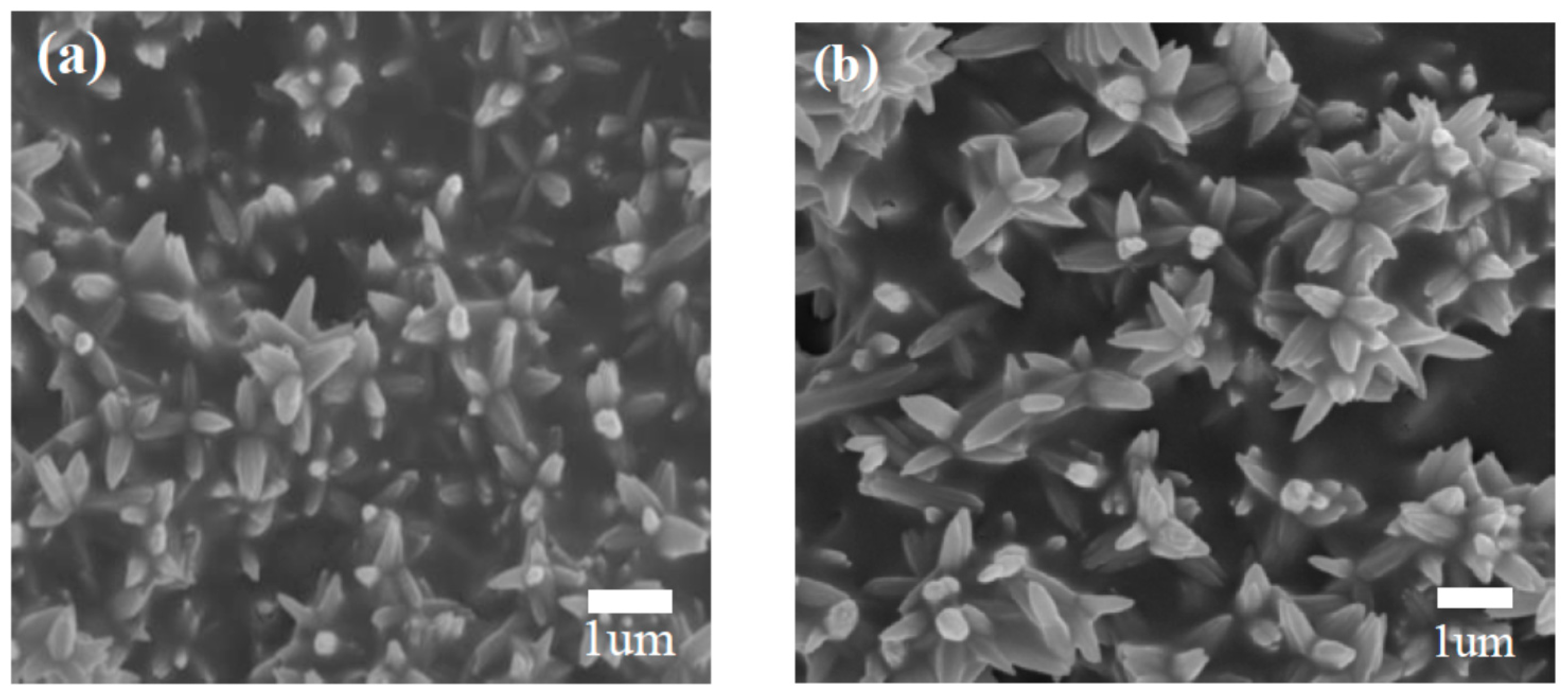
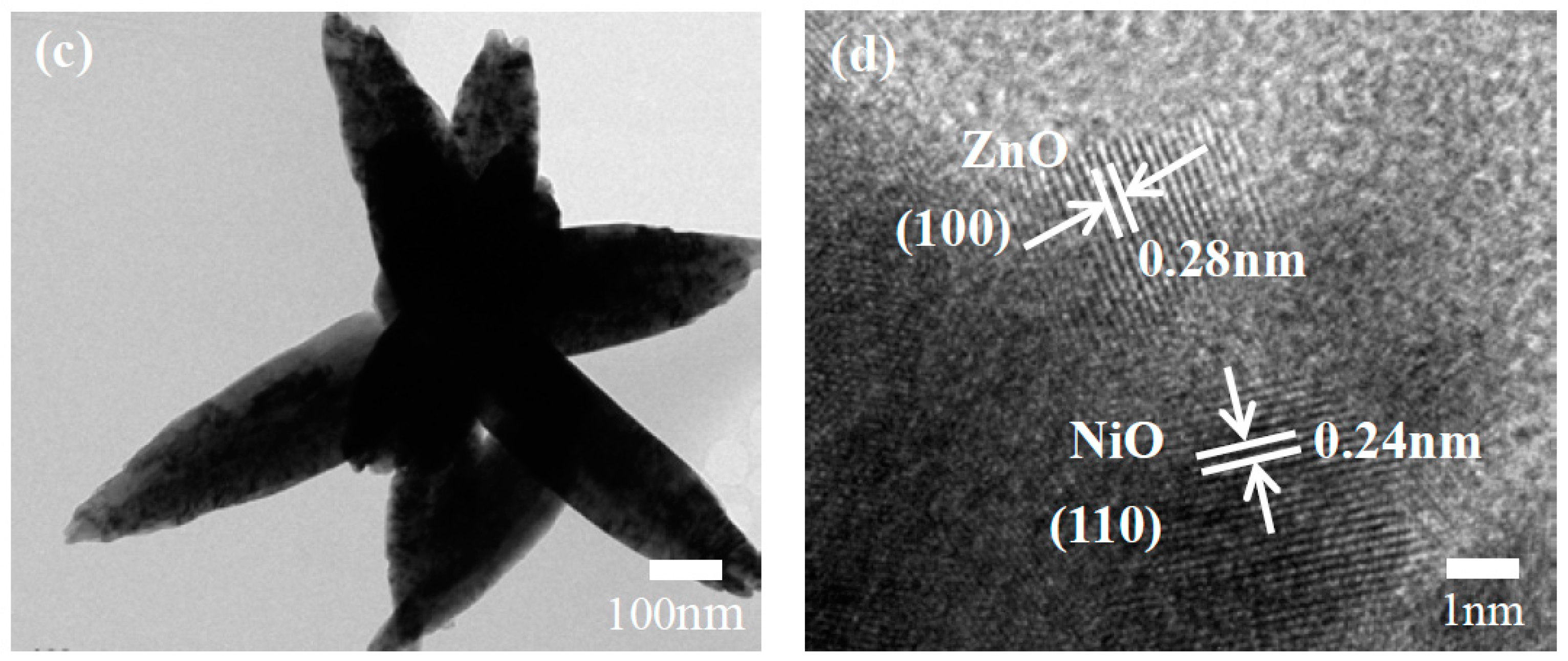
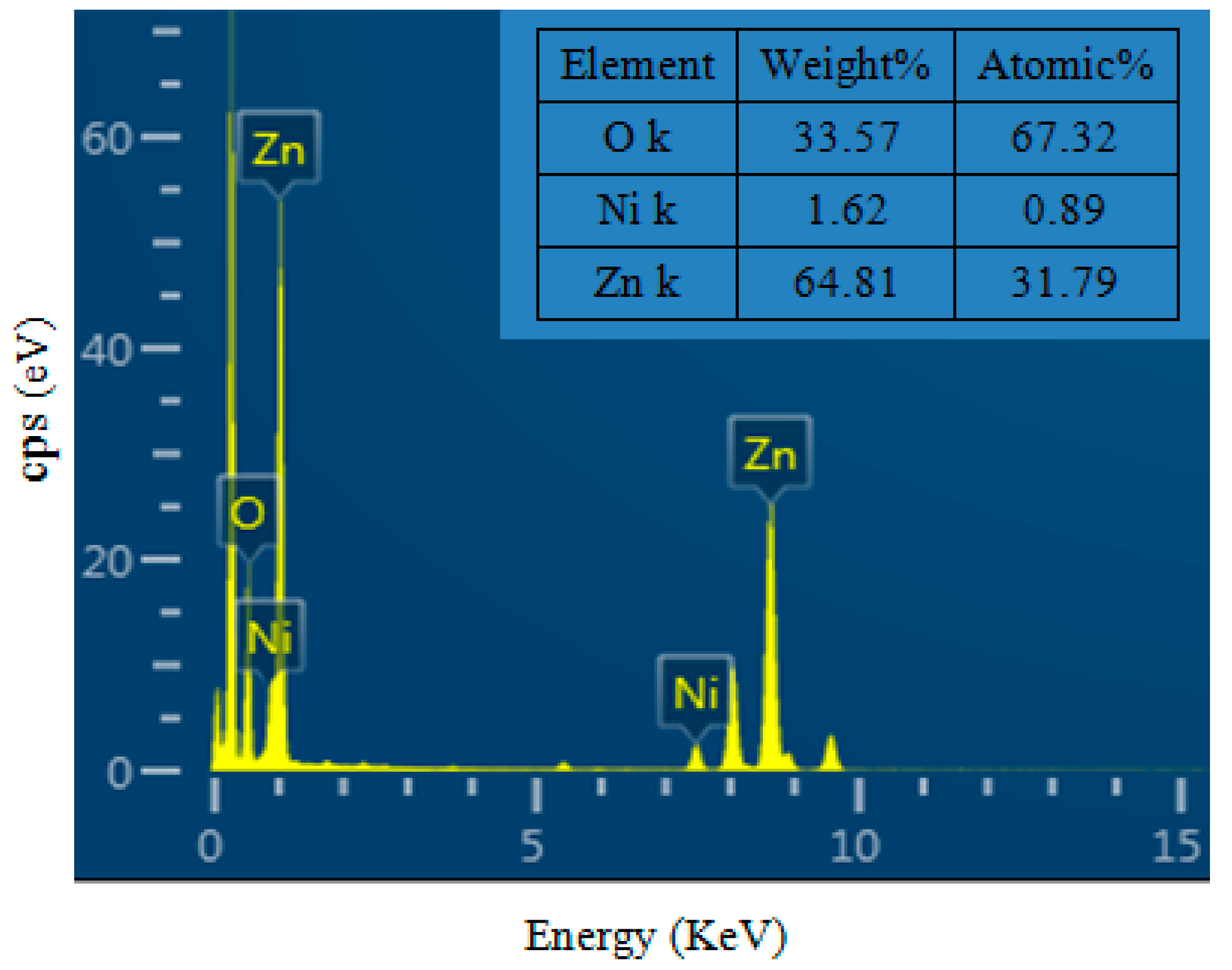
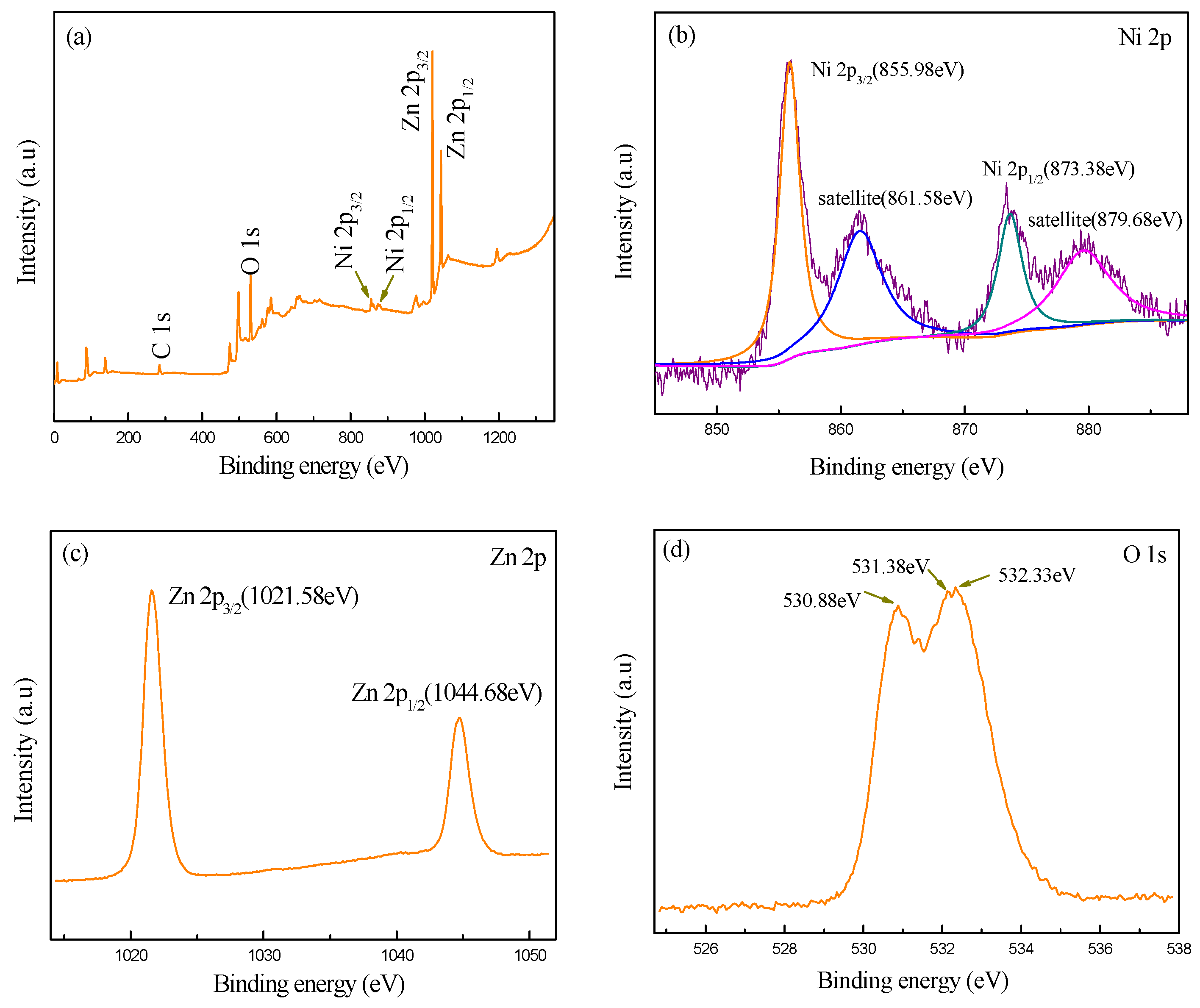
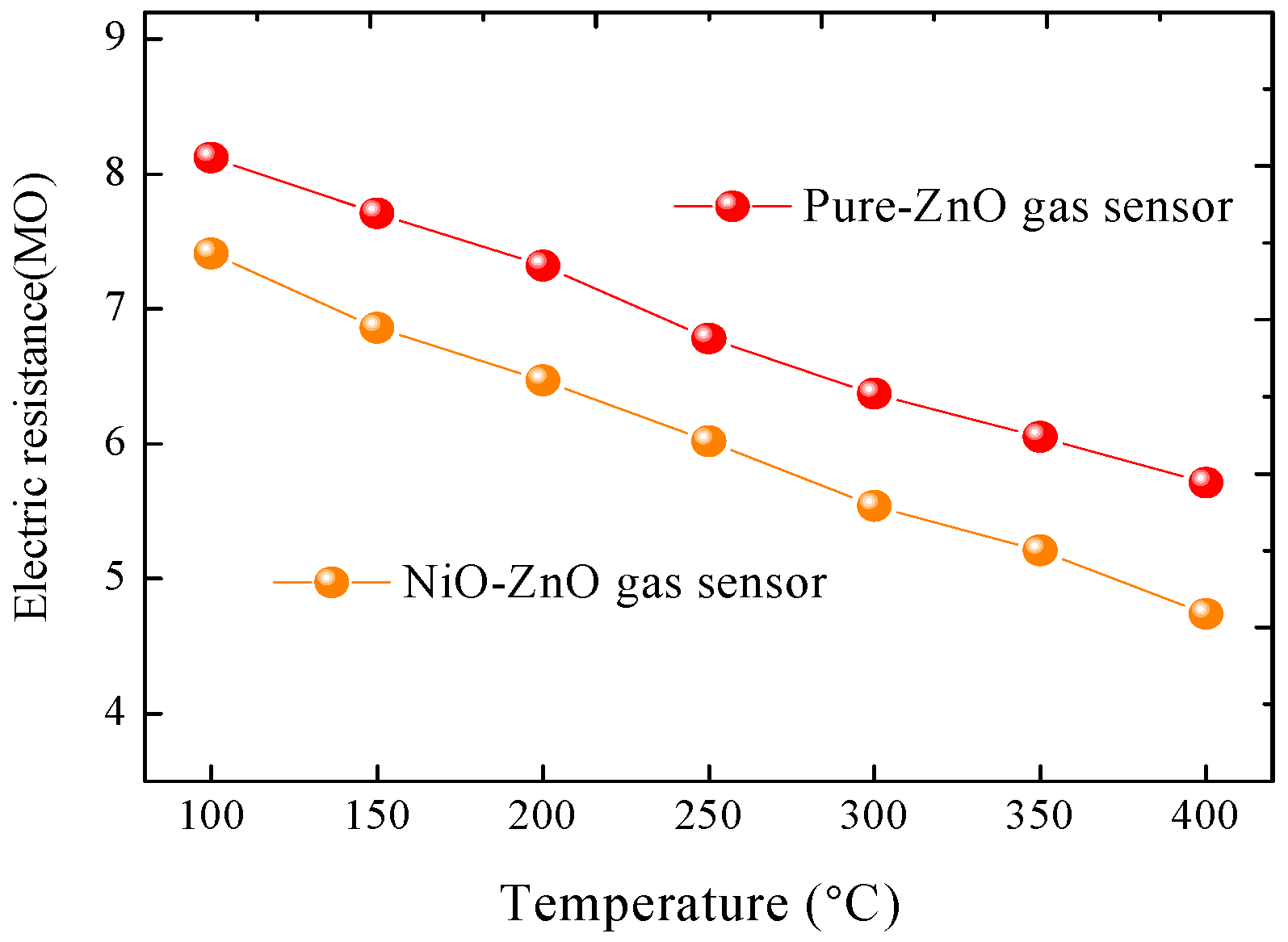

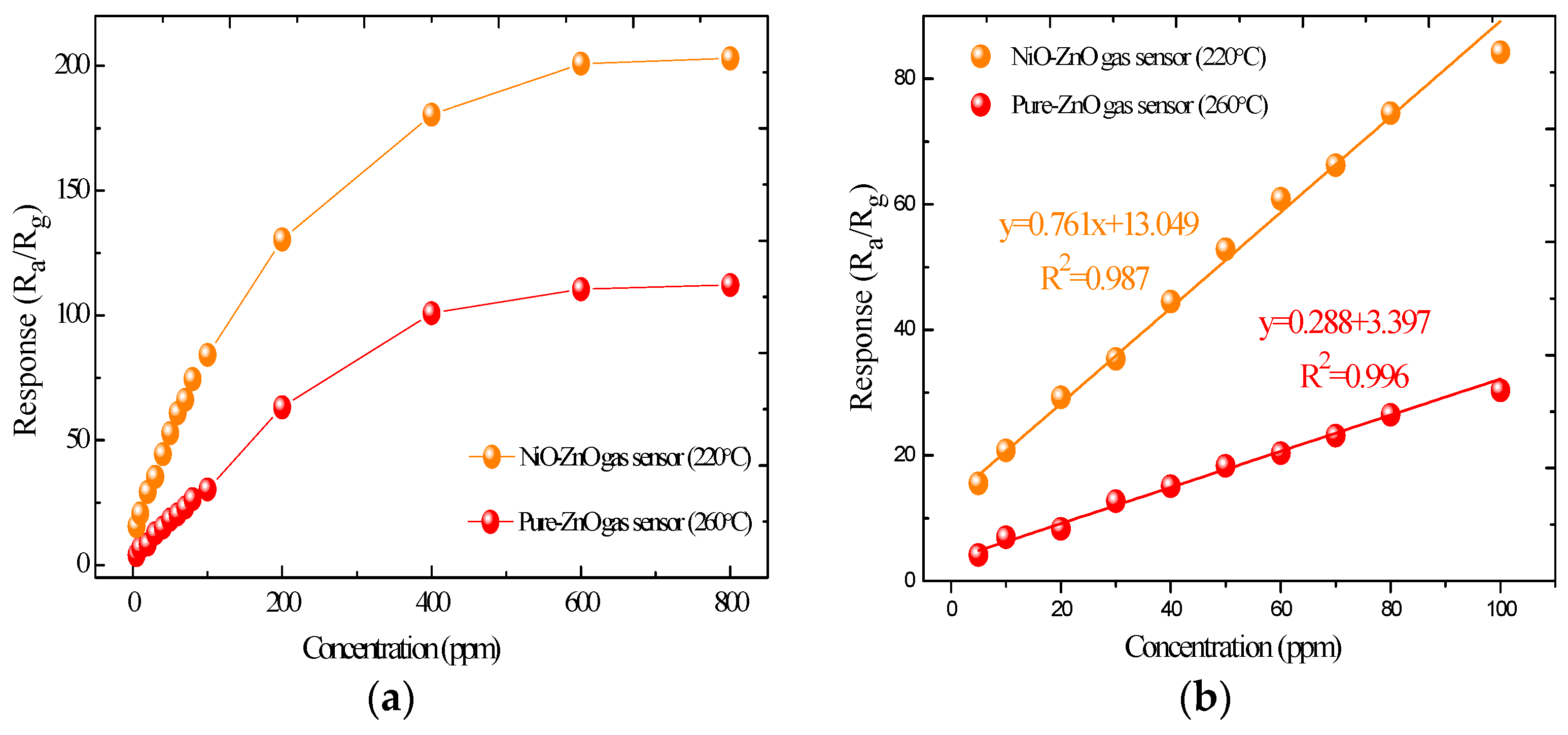
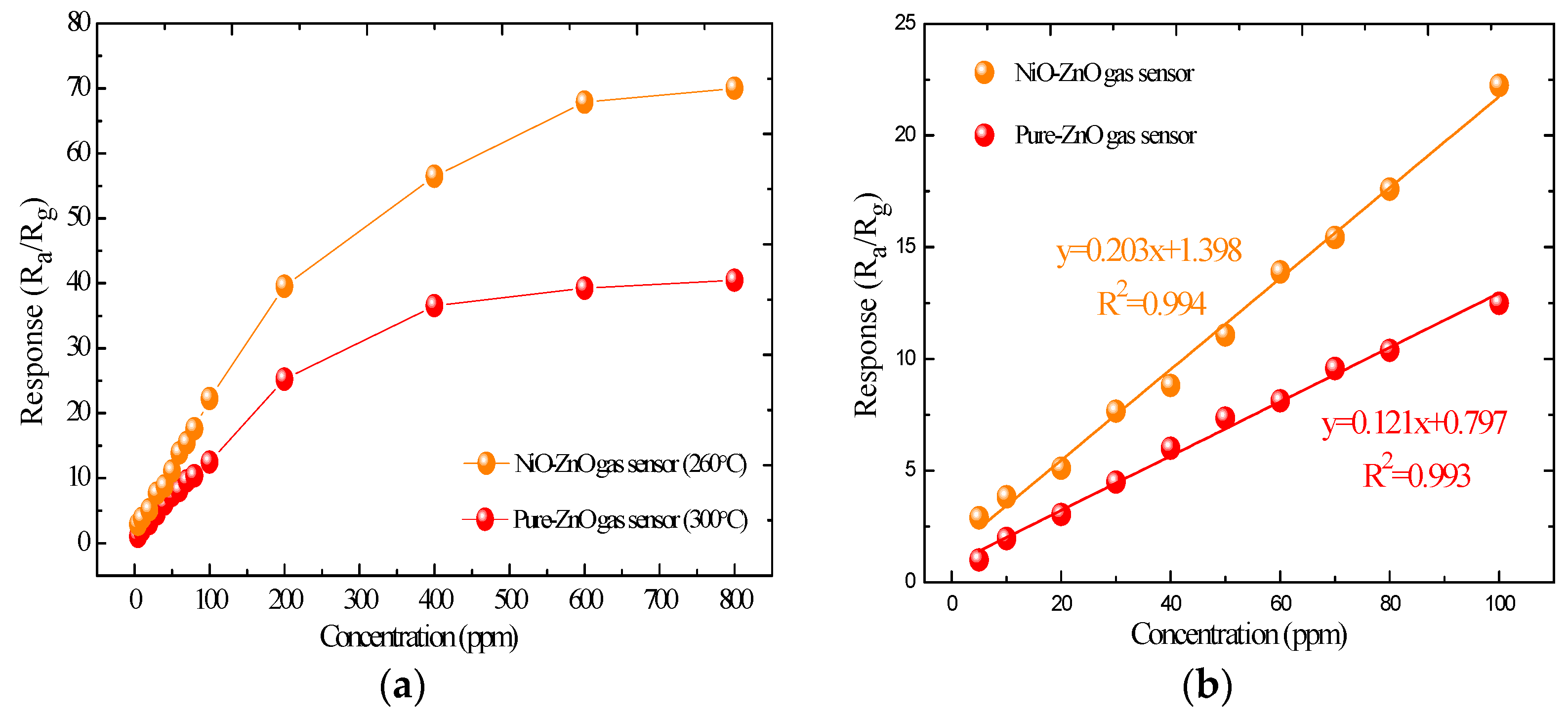
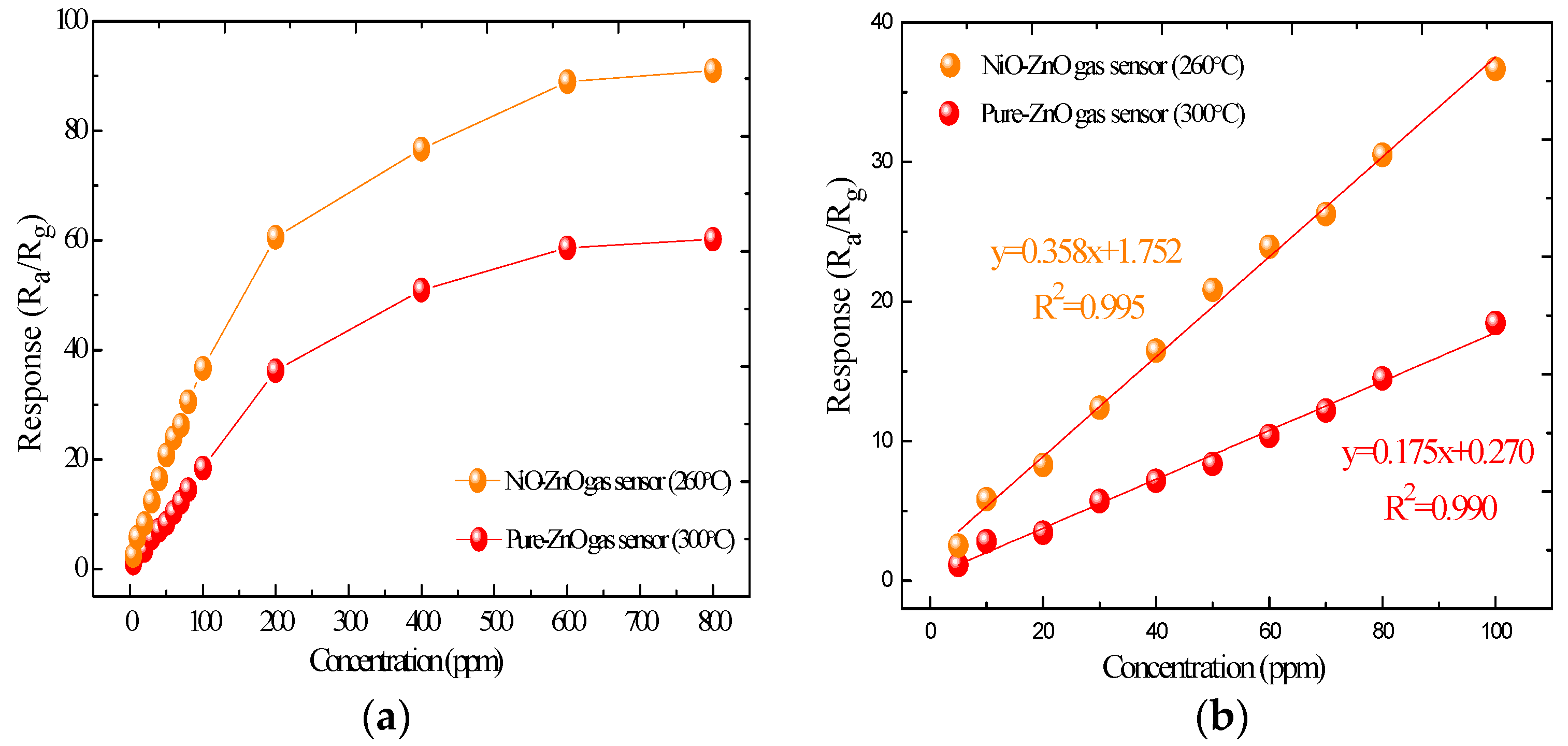
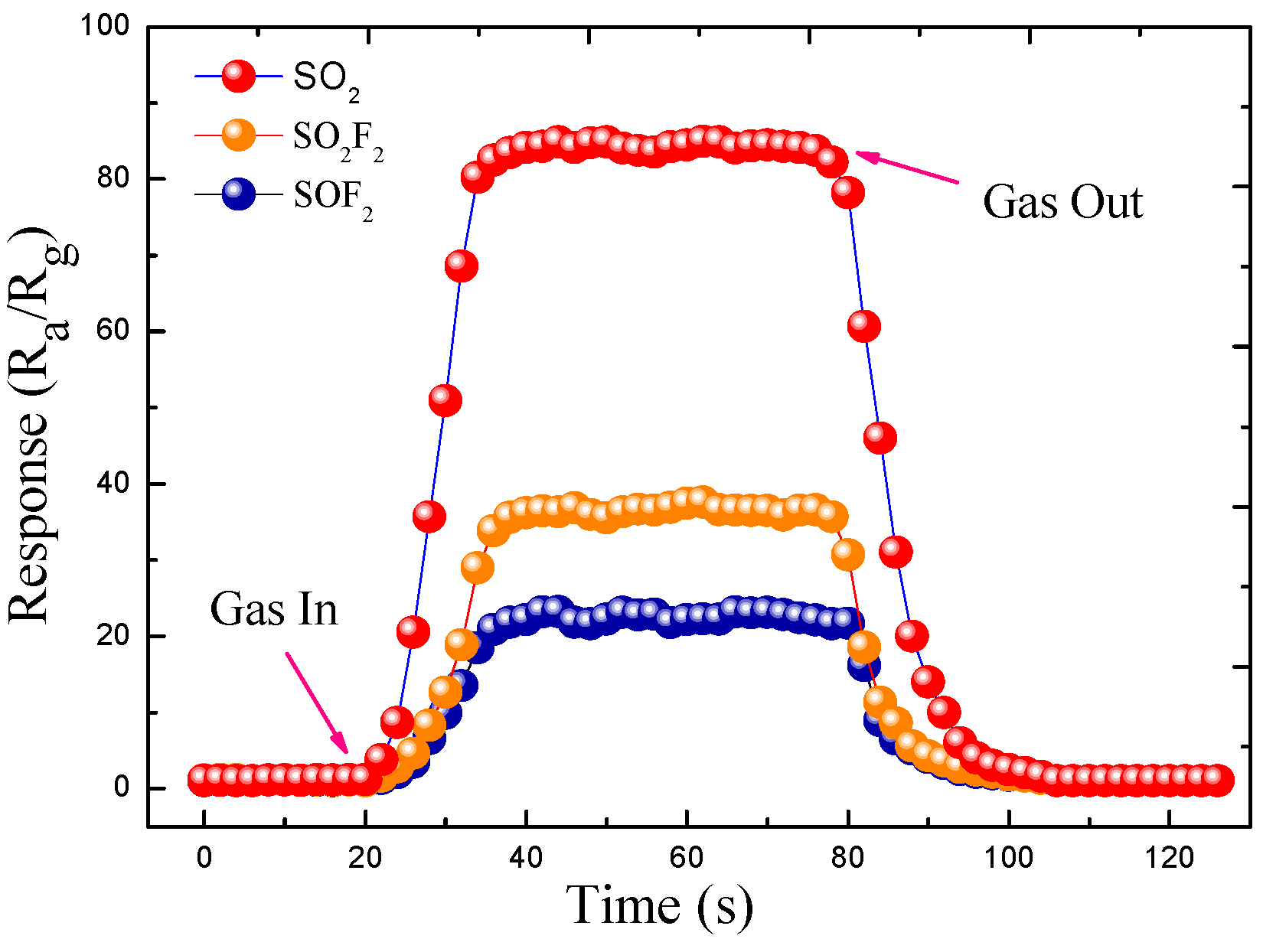
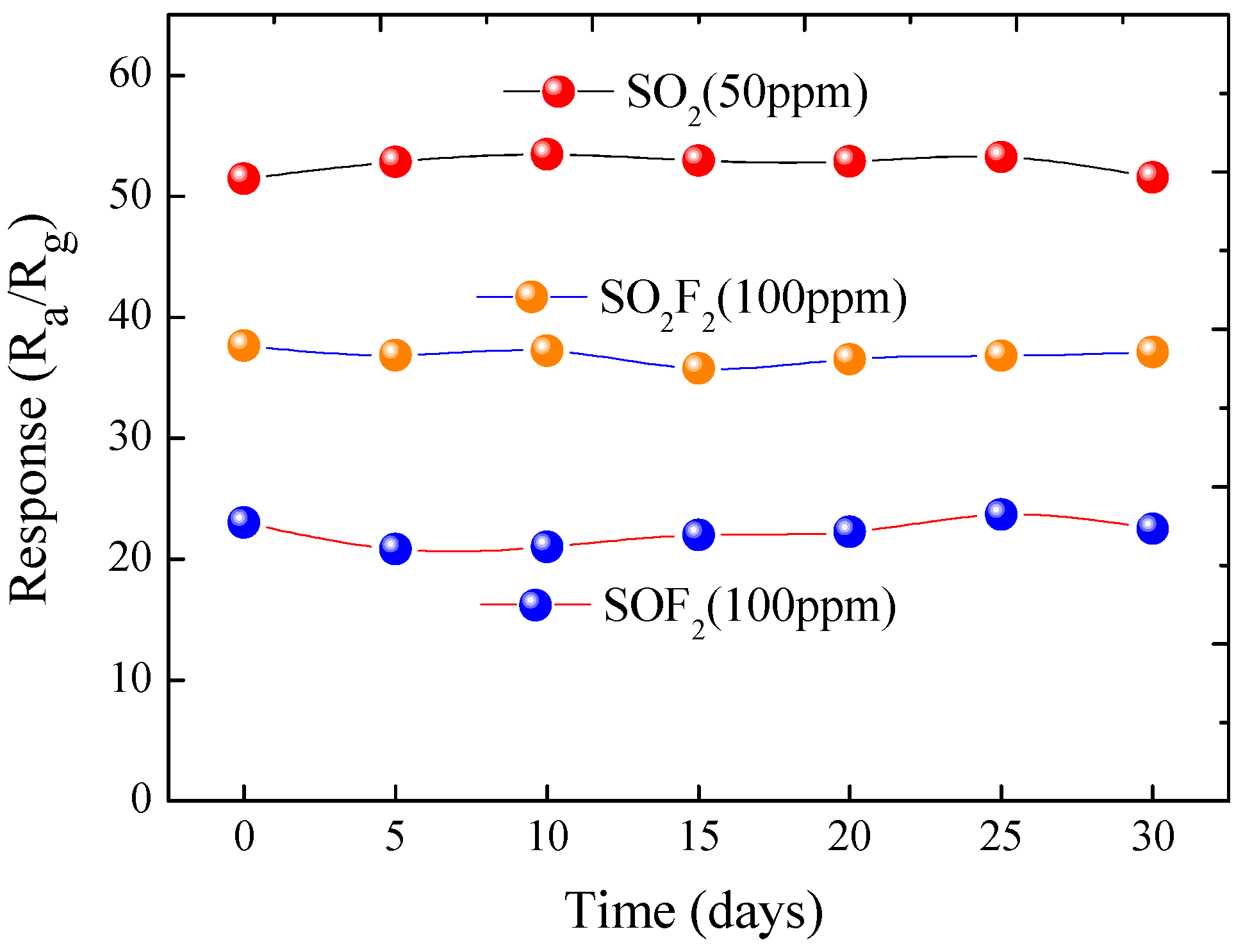
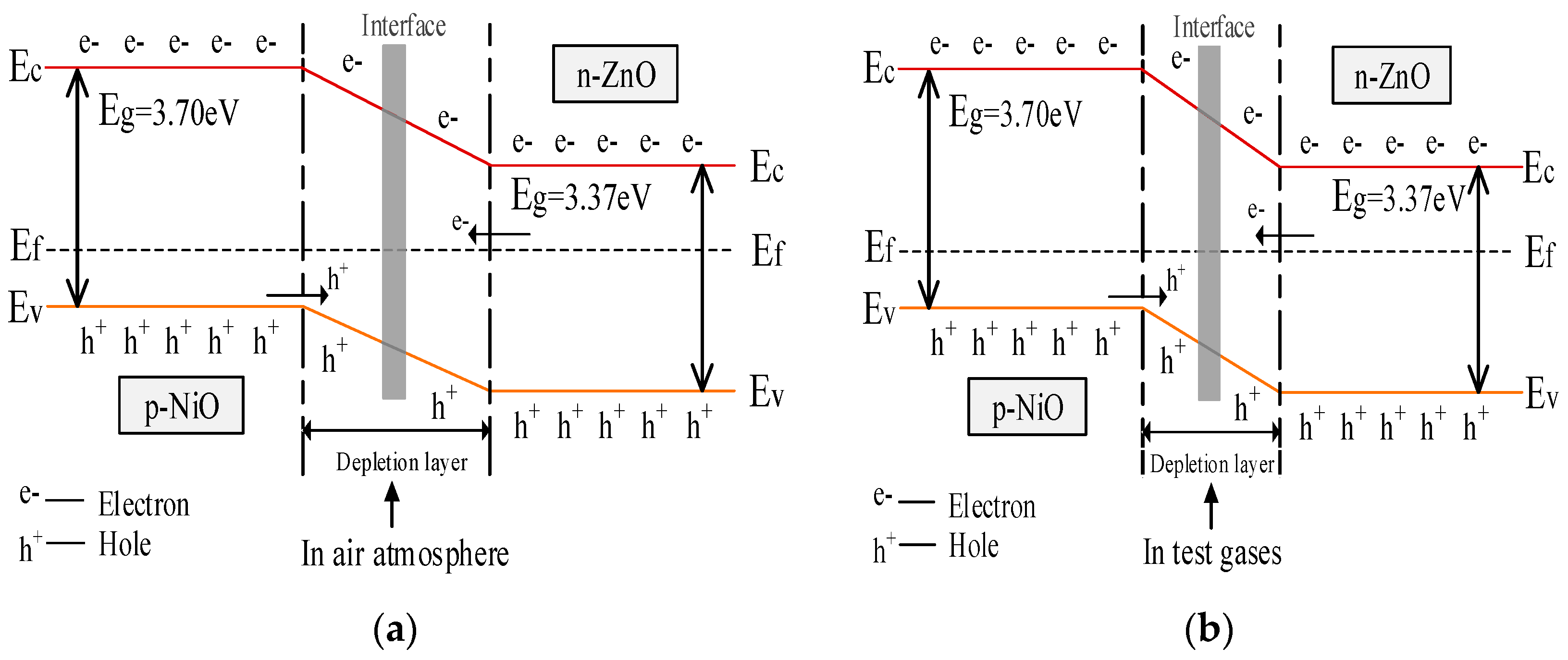
© 2017 by the authors. Licensee MDPI, Basel, Switzerland. This article is an open access article distributed under the terms and conditions of the Creative Commons Attribution (CC BY) license (http://creativecommons.org/licenses/by/4.0/).
Share and Cite
Liu, H.; Zhou, Q.; Zhang, Q.; Hong, C.; Xu, L.; Jin, L.; Chen, W. Synthesis, Characterization and Enhanced Sensing Properties of a NiO/ZnO p–n Junctions Sensor for the SF6 Decomposition Byproducts SO2, SO2F2, and SOF2. Sensors 2017, 17, 913. https://doi.org/10.3390/s17040913
Liu H, Zhou Q, Zhang Q, Hong C, Xu L, Jin L, Chen W. Synthesis, Characterization and Enhanced Sensing Properties of a NiO/ZnO p–n Junctions Sensor for the SF6 Decomposition Byproducts SO2, SO2F2, and SOF2. Sensors. 2017; 17(4):913. https://doi.org/10.3390/s17040913
Chicago/Turabian StyleLiu, Hongcheng, Qu Zhou, Qingyan Zhang, Changxiang Hong, Lingna Xu, Lingfeng Jin, and Weigen Chen. 2017. "Synthesis, Characterization and Enhanced Sensing Properties of a NiO/ZnO p–n Junctions Sensor for the SF6 Decomposition Byproducts SO2, SO2F2, and SOF2" Sensors 17, no. 4: 913. https://doi.org/10.3390/s17040913
APA StyleLiu, H., Zhou, Q., Zhang, Q., Hong, C., Xu, L., Jin, L., & Chen, W. (2017). Synthesis, Characterization and Enhanced Sensing Properties of a NiO/ZnO p–n Junctions Sensor for the SF6 Decomposition Byproducts SO2, SO2F2, and SOF2. Sensors, 17(4), 913. https://doi.org/10.3390/s17040913






